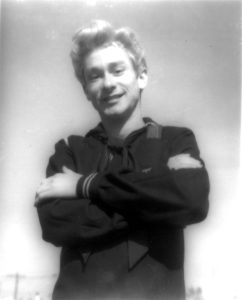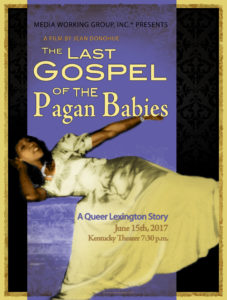A Queer Trilogy
I didn’t start out to make films about the LGBQT community in central Kentucky. It’s just that as a young artist coming of age in Lexington, Kentucky in the 1970s they were the most interesting, authentically creative people I knew. My friends were complex, having layers of experience and vulnerability in society that was challenging to understand. Now, much later in life, it’s still true and as a filmmaker their life stories have become even more interesting, important, and iconic.
Jean Donohue
Under the Southern Cross, The Life and Times of Henry Faulkner

The Last Gospel of the Pagan Babies
This documentary excavates a 150 year old, gender-bending, sexual outlaw community in the American south of Lexington, Kentucky.
This Kentucky lineage of gay pioneers and rebels grew strong underground. They documented their identity and history as a community through shared storytelling, troves of personal photographs, home movies, and early video. The archives include cross-dressing guerilla soldier Sue Mundy, who fought in the Civil War. Sweet Evening Breeze, the notorious transgender, black drag queen was born in the 1880s and entertained Lexington until xxx. Artists Henry Faulkner and Bob Morgan worked with, and partied with Tennessee Williams. Hollywood movie star Rock Hudson would come through town as the owner of its only gay bar.

Native Daughter
This film, in progress, is about Cherie D Collins a farmer, writer and spoken word performance artist who identifies as lesbian. Collins decided to come back to her childhood home in Mt. Sterling, Kentucky after spending thirty years in Boston. She is a recognized, successful writer and musician with two books of poetry, three CDs and is known for being one of the first spoken word artists in Boston. Even with this success, there was something wrong. Her relationships seemed to be stages upon which the same drama of anger, terror, and feelings of powerlessness is being enacted over and over. Her health is deteriorating with more and more frequent emergency room visits, panic attacks, and adrenal failure. She realizes she has PTSD, but why? She knew her little farm in Mt. Sterling was suffering too, toxic from farm renter’s chemical based cropping, dumping toxic trash, and her pond used by neighbors to empty their chlorine-tainted pool water. Her land was suffering she was suffering. She returns to Mt. Sterling for solace, peace and family, this is a story about what happened.